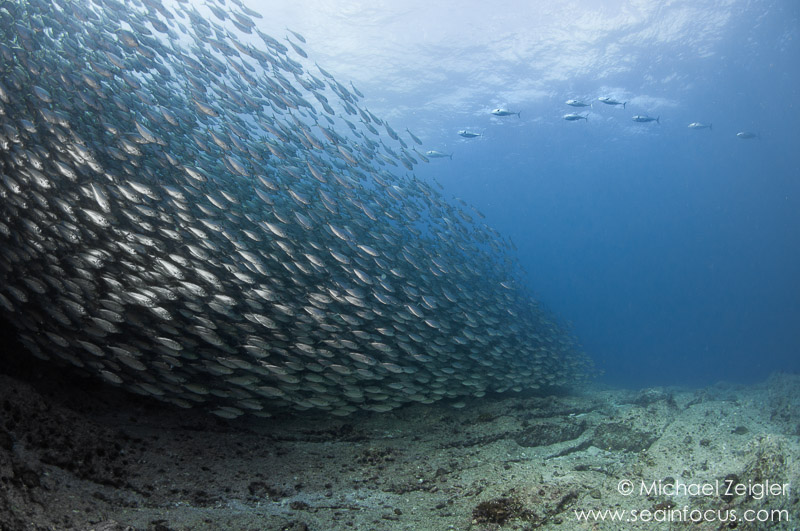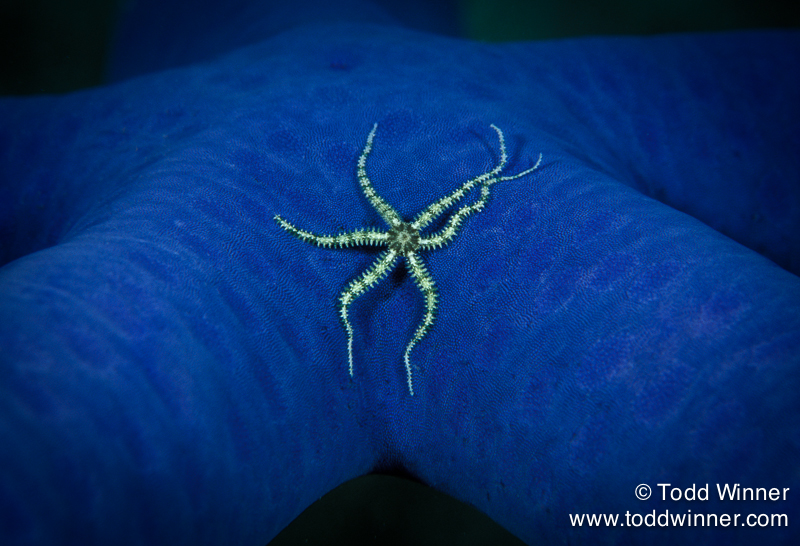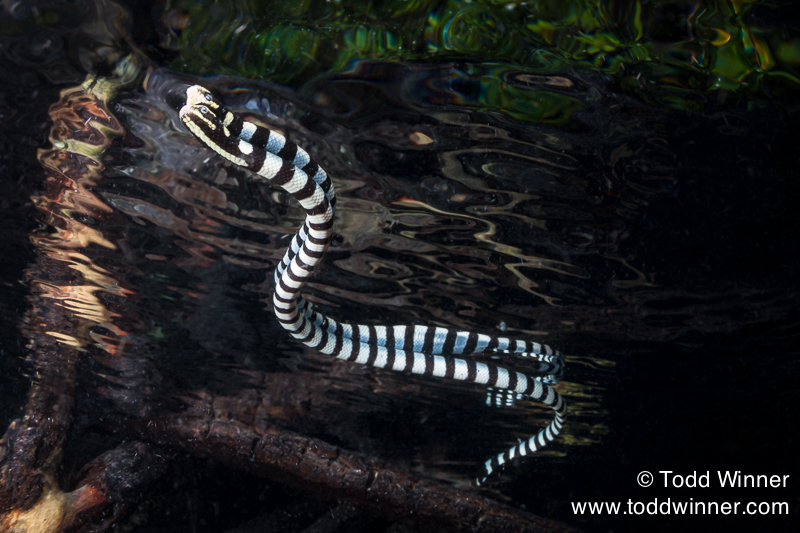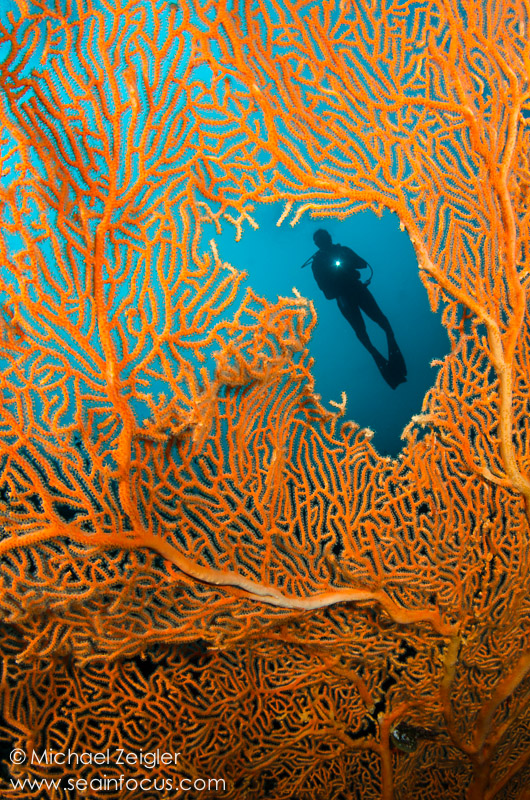Written by Michael Zeigler Photos by Michael Zeigler and Todd Winner
Have you ever taken a photo, reviewed it on the LCD screen, and thought to yourself, "Nailed it!"? Chances are you have, and chances are it wasn't by accident. We've put together our 10 Top Tips for Amazing Underwater Photos, and we'll share some of our favorite underwater photos as well.
TIP #1 GET CLOSE: Get close (and then get closer) is the underwater photographer's moniker. And sometimes that means getting uncomfortably close. I am by no means endorsing getting anywhere near a dangerous critter. However, Todd Winner did, and the image below is awesome.
 American alligator - Nikon D2X, Tokina 10-17mm, 1/125, f/13, ISO 200
TIP #2 DO YOUR HOMEWORK: Whether it's via the internet, books, or talking to fellow divers, be sure you know what you're looking for, and where to find it. Knowing how to approach certain subjects is paramount as well. You've invested a lot of time and money before you even giant-stride off the boat. You may as well go the extra mile and study your subject and location.
TIP #3 BE PREPARED: You never know when a potentially great subject will present itself. When entering the water while shooting wide-angle, I always start with my camera settings set to 1/125, F8, ISO 320, strobes out to the sides at 1/2 power.
American alligator - Nikon D2X, Tokina 10-17mm, 1/125, f/13, ISO 200
TIP #2 DO YOUR HOMEWORK: Whether it's via the internet, books, or talking to fellow divers, be sure you know what you're looking for, and where to find it. Knowing how to approach certain subjects is paramount as well. You've invested a lot of time and money before you even giant-stride off the boat. You may as well go the extra mile and study your subject and location.
TIP #3 BE PREPARED: You never know when a potentially great subject will present itself. When entering the water while shooting wide-angle, I always start with my camera settings set to 1/125, F8, ISO 320, strobes out to the sides at 1/2 power.
 While diving in La Paz, this massive bait ball suddenly came streaming next to me while the bonito charged from above. I had just enough time to fire two shots before it was gone. I'm convinced I would have missed the shot if my camera had not been set to my default settings.
TIP #4 CONNECT WITH THE VIEWER: This is most often done by having solid eye contact with the subject. Just make sure that the eyes are in sharp focus.
While diving in La Paz, this massive bait ball suddenly came streaming next to me while the bonito charged from above. I had just enough time to fire two shots before it was gone. I'm convinced I would have missed the shot if my camera had not been set to my default settings.
TIP #4 CONNECT WITH THE VIEWER: This is most often done by having solid eye contact with the subject. Just make sure that the eyes are in sharp focus.
 TIP #5 FIND AN UNCOMMON SUBJECT: These always seem to get the attention of the viewer. Or, photograph a common subject in an uncommon way.
TIP #6 USE THE RIGHT TOOL FOR THE SHOT: This ties back to #2 (do your homework), and it's imperative that you have the right equipment to get the shot you're after. Would a mini dome be more useful than a large dome? Would you be better off using a 105mm macro lens or a 60mm macro lens?
TIP #5 FIND AN UNCOMMON SUBJECT: These always seem to get the attention of the viewer. Or, photograph a common subject in an uncommon way.
TIP #6 USE THE RIGHT TOOL FOR THE SHOT: This ties back to #2 (do your homework), and it's imperative that you have the right equipment to get the shot you're after. Would a mini dome be more useful than a large dome? Would you be better off using a 105mm macro lens or a 60mm macro lens?
 Using a large 8" dome allowed me to more easily capture this open water split shot than if I were using my 4" Zen dome.
TIP #7 FILL THE FRAME: Successful portrait images tend to dominate a majority of the image. The subject occupies most of the frame, and may include a bit of its environment.
Using a large 8" dome allowed me to more easily capture this open water split shot than if I were using my 4" Zen dome.
TIP #7 FILL THE FRAME: Successful portrait images tend to dominate a majority of the image. The subject occupies most of the frame, and may include a bit of its environment.
 Tiny brittle star on blue sea star: Fiji - Nikon N90, 105mm lens, Velvia 50
TIP #8 USE THE SURFACE: Reflections are a great way to enhance an underwater marine life portrait, as it not only shows the viewer exactly where the subject is in the water column, but also adds an artistic touch to the photograph.
Tiny brittle star on blue sea star: Fiji - Nikon N90, 105mm lens, Velvia 50
TIP #8 USE THE SURFACE: Reflections are a great way to enhance an underwater marine life portrait, as it not only shows the viewer exactly where the subject is in the water column, but also adds an artistic touch to the photograph.
 A venomous black and white sea krait swims along with its own reflection near the surface of an Indonesian mangrove. Raja Ampat, Indonesia- Canon 7D, EF8-15mm, 1/200, f/8.0, ISO 100
TIP #9 GO INTO STEALTH MODE: How you approach a subject can be the difference between getting the shot and, well, ... not. I've found that eye contact is ok, as long as it's not both eyes staring right at the subject. Animals often interpret direct eye contact as a threat, since you're focused solely on them. Avoiding this will allow you to get relatively close and capture that crisp, colorful photo that you prepared for.
A venomous black and white sea krait swims along with its own reflection near the surface of an Indonesian mangrove. Raja Ampat, Indonesia- Canon 7D, EF8-15mm, 1/200, f/8.0, ISO 100
TIP #9 GO INTO STEALTH MODE: How you approach a subject can be the difference between getting the shot and, well, ... not. I've found that eye contact is ok, as long as it's not both eyes staring right at the subject. Animals often interpret direct eye contact as a threat, since you're focused solely on them. Avoiding this will allow you to get relatively close and capture that crisp, colorful photo that you prepared for.
 Sweetlips and Diver, Raja Ampat, Indonesia - Canon 7D, EF8-15mm, 1/320, f/8.0, ISO 100
TIP #10 USE A MODEL: Adding the "human element" can make an ordinarily "normal" subject into a visually captivating one.
Sweetlips and Diver, Raja Ampat, Indonesia - Canon 7D, EF8-15mm, 1/320, f/8.0, ISO 100
TIP #10 USE A MODEL: Adding the "human element" can make an ordinarily "normal" subject into a visually captivating one.
 A diver passes over a large sea fan along the wall of Sawa Utara - Wakatobi.
A diver passes over a large sea fan along the wall of Sawa Utara - Wakatobi.
 American alligator - Nikon D2X, Tokina 10-17mm, 1/125, f/13, ISO 200
TIP #2 DO YOUR HOMEWORK: Whether it's via the internet, books, or talking to fellow divers, be sure you know what you're looking for, and where to find it. Knowing how to approach certain subjects is paramount as well. You've invested a lot of time and money before you even giant-stride off the boat. You may as well go the extra mile and study your subject and location.
TIP #3 BE PREPARED: You never know when a potentially great subject will present itself. When entering the water while shooting wide-angle, I always start with my camera settings set to 1/125, F8, ISO 320, strobes out to the sides at 1/2 power.
American alligator - Nikon D2X, Tokina 10-17mm, 1/125, f/13, ISO 200
TIP #2 DO YOUR HOMEWORK: Whether it's via the internet, books, or talking to fellow divers, be sure you know what you're looking for, and where to find it. Knowing how to approach certain subjects is paramount as well. You've invested a lot of time and money before you even giant-stride off the boat. You may as well go the extra mile and study your subject and location.
TIP #3 BE PREPARED: You never know when a potentially great subject will present itself. When entering the water while shooting wide-angle, I always start with my camera settings set to 1/125, F8, ISO 320, strobes out to the sides at 1/2 power.
 While diving in La Paz, this massive bait ball suddenly came streaming next to me while the bonito charged from above. I had just enough time to fire two shots before it was gone. I'm convinced I would have missed the shot if my camera had not been set to my default settings.
TIP #4 CONNECT WITH THE VIEWER: This is most often done by having solid eye contact with the subject. Just make sure that the eyes are in sharp focus.
While diving in La Paz, this massive bait ball suddenly came streaming next to me while the bonito charged from above. I had just enough time to fire two shots before it was gone. I'm convinced I would have missed the shot if my camera had not been set to my default settings.
TIP #4 CONNECT WITH THE VIEWER: This is most often done by having solid eye contact with the subject. Just make sure that the eyes are in sharp focus.
 TIP #5 FIND AN UNCOMMON SUBJECT: These always seem to get the attention of the viewer. Or, photograph a common subject in an uncommon way.
TIP #6 USE THE RIGHT TOOL FOR THE SHOT: This ties back to #2 (do your homework), and it's imperative that you have the right equipment to get the shot you're after. Would a mini dome be more useful than a large dome? Would you be better off using a 105mm macro lens or a 60mm macro lens?
TIP #5 FIND AN UNCOMMON SUBJECT: These always seem to get the attention of the viewer. Or, photograph a common subject in an uncommon way.
TIP #6 USE THE RIGHT TOOL FOR THE SHOT: This ties back to #2 (do your homework), and it's imperative that you have the right equipment to get the shot you're after. Would a mini dome be more useful than a large dome? Would you be better off using a 105mm macro lens or a 60mm macro lens?
 Using a large 8" dome allowed me to more easily capture this open water split shot than if I were using my 4" Zen dome.
TIP #7 FILL THE FRAME: Successful portrait images tend to dominate a majority of the image. The subject occupies most of the frame, and may include a bit of its environment.
Using a large 8" dome allowed me to more easily capture this open water split shot than if I were using my 4" Zen dome.
TIP #7 FILL THE FRAME: Successful portrait images tend to dominate a majority of the image. The subject occupies most of the frame, and may include a bit of its environment.
 Tiny brittle star on blue sea star: Fiji - Nikon N90, 105mm lens, Velvia 50
TIP #8 USE THE SURFACE: Reflections are a great way to enhance an underwater marine life portrait, as it not only shows the viewer exactly where the subject is in the water column, but also adds an artistic touch to the photograph.
Tiny brittle star on blue sea star: Fiji - Nikon N90, 105mm lens, Velvia 50
TIP #8 USE THE SURFACE: Reflections are a great way to enhance an underwater marine life portrait, as it not only shows the viewer exactly where the subject is in the water column, but also adds an artistic touch to the photograph.
 A venomous black and white sea krait swims along with its own reflection near the surface of an Indonesian mangrove. Raja Ampat, Indonesia- Canon 7D, EF8-15mm, 1/200, f/8.0, ISO 100
TIP #9 GO INTO STEALTH MODE: How you approach a subject can be the difference between getting the shot and, well, ... not. I've found that eye contact is ok, as long as it's not both eyes staring right at the subject. Animals often interpret direct eye contact as a threat, since you're focused solely on them. Avoiding this will allow you to get relatively close and capture that crisp, colorful photo that you prepared for.
A venomous black and white sea krait swims along with its own reflection near the surface of an Indonesian mangrove. Raja Ampat, Indonesia- Canon 7D, EF8-15mm, 1/200, f/8.0, ISO 100
TIP #9 GO INTO STEALTH MODE: How you approach a subject can be the difference between getting the shot and, well, ... not. I've found that eye contact is ok, as long as it's not both eyes staring right at the subject. Animals often interpret direct eye contact as a threat, since you're focused solely on them. Avoiding this will allow you to get relatively close and capture that crisp, colorful photo that you prepared for.
 Sweetlips and Diver, Raja Ampat, Indonesia - Canon 7D, EF8-15mm, 1/320, f/8.0, ISO 100
TIP #10 USE A MODEL: Adding the "human element" can make an ordinarily "normal" subject into a visually captivating one.
Sweetlips and Diver, Raja Ampat, Indonesia - Canon 7D, EF8-15mm, 1/320, f/8.0, ISO 100
TIP #10 USE A MODEL: Adding the "human element" can make an ordinarily "normal" subject into a visually captivating one.
 A diver passes over a large sea fan along the wall of Sawa Utara - Wakatobi.
A diver passes over a large sea fan along the wall of Sawa Utara - Wakatobi.





